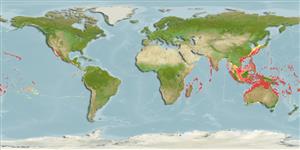Environment: milieu / climate zone / depth range / distribution range
Ecología
marino asociado a arrecife; rango de profundidad 9 - 170 m (Ref. 30874), usually 16 - ? m (Ref. 9710). Tropical
Indo-Pacific: East Africa to Pitcairn (excluding Easter Island), north to Japan, south to the Great Barrier Reef. Throughout Oceania. Not recorded from the Arabian Peninsula or the southern coast of Asia.
Tamaño / Peso / Age
Maturity: Lm ? range ? - ? cm
Max length : 18.0 cm TL macho / no sexado; (Ref. 48636)
Espinas dorsales (total): 5; Radios blandos dorsales (total): 21-22; Espinas anales 1; Radios blandos anales: 17 - 18. Indian Ocean form shows lined versus barred pattern (Ref. 48636). Spinous portion of dorsal fin black at base, deep red distally. A longitudinal row of black spots 8 or 9 subquadrangular red to dark brown spots along back alternating with similar but more vertically elongate red spots on lower side. Two narrow bright red bars at pectoral-fin base (Ref 42740).
Benthic (Ref. 58302). Usually on open sand and rubble substrates near reefs (Ref. 48636, 58302). Adults occur on deep seaward and coastal slopes and deep sand flats (Ref. 48636) at depths to 170 m and rises up to about 15 m to feed (Ref. 90102). Adults have lyre-tail and may swim high above the substrate to feed on zooplankton, usually amongst other fishes such as basslets (Ref. 48636). Minimum depth of 9 m reported from Ref. 30874.
Life cycle and mating behavior
Madurez | Reproducción | Puesta | Huevos | Fecundidad | Larva
Randall, J.E., G.R. Allen and R.C. Steene, 1990. Fishes of the Great Barrier Reef and Coral Sea. University of Hawaii Press, Honolulu, Hawaii. 506 p. (Ref. 2334)
IUCN Red List Status (Ref. 130435)
Threat to humans
Harmless
Human uses
Acuario: Comercial
Más información
Nombres comunesSinónimosMetabolismoDespredadoresEcotoxicologíaReproducciónMadurezPuestaAgregación para la puestaFecundidadHuevosEgg development
ReferenciasAcuiculturaPerfil de acuiculturaRazasGenéticaElectrophoresesheritabilidadEnfermedadesProcesamientoNutrientsMass conversion
Herramientas
Special reports
Download XML
Fuentes de Internet
Estimates based on models
Preferred temperature (Ref.
123201): 22.4 - 28.8, mean 27 °C (based on 884 cells).
Phylogenetic diversity index (Ref.
82804): PD
50 = 0.5000 [Uniqueness, from 0.5 = low to 2.0 = high].
Bayesian length-weight: a=0.00692 (0.00311 - 0.01538), b=3.06 (2.88 - 3.24), in cm total length, based on LWR estimates for this Genus-body shape (Ref.
93245).
Nivel trófico (Ref.
69278): 3.4 ±0.45 se; based on food items.
Resiliencia (Ref.
120179): Alto, población duplicada en un tiempo mínimo inferior a 15 meses (Preliminary K or Fecundity.).
Fishing Vulnerability (Ref.
59153): Low vulnerability (10 of 100).
Nutrients (Ref.
124155): Calcium = 90.6 [48.1, 143.0] mg/100g; Iron = 0.773 [0.480, 1.265] mg/100g; Protein = 17.8 [15.5, 19.8] %; Omega3 = 0.111 [0.065, 0.196] g/100g; Selenium = 39.5 [20.5, 80.9] μg/100g; VitaminA = 142 [52, 416] μg/100g; Zinc = 1.4 [1.0, 1.9] mg/100g (wet weight);
